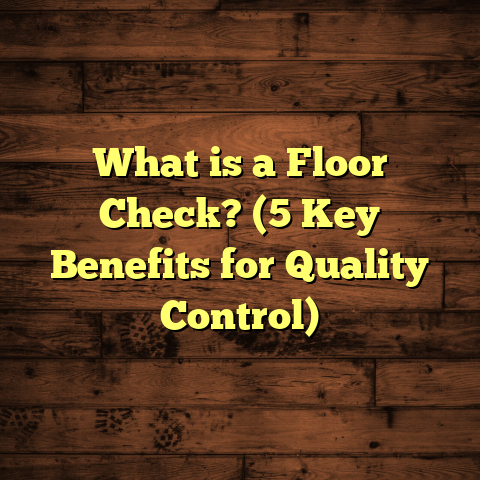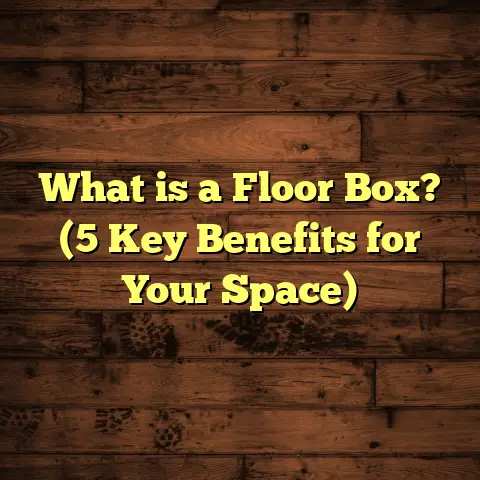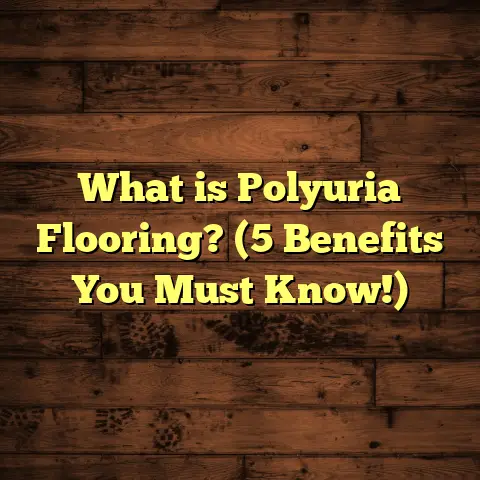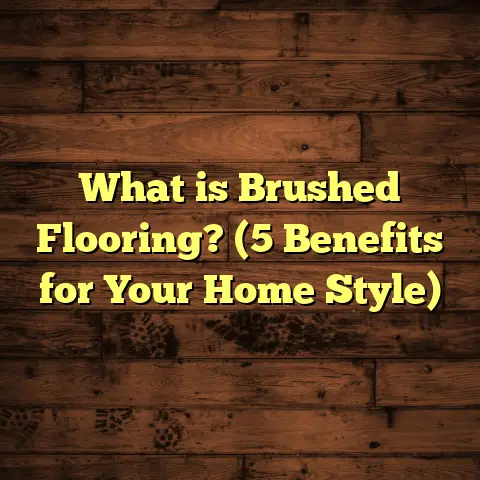What is Broadloom Flooring? (5 Key Benefits for Your Home)
Here is the extended article on “What is Broadloom Flooring? (5 Key Benefits for Your Home)”.
I’ve always been fascinated by how flooring shapes the entire vibe of a home. When I first discovered broadloom flooring, it quickly became my go-to recommendation for clients who wanted a luxurious feel paired with durability and style. There’s something about the way broadloom carpets wrap a room in warmth and softness that no other flooring material quite matches.
If you’re curious about what broadloom flooring really means, how it compares to other carpet options, and why it might be a perfect fit for your home, pull up a chair. I’m going to break down everything I’ve learned over years of installing broadloom in countless houses. I’ll share my personal stories, detailed data, pricing insights, and even some research-backed facts to give you a full picture.
What is Broadloom Flooring?
Broadloom flooring refers to carpet made on wide looms that produce large rolls of carpet material, usually 12 feet wide or sometimes 13.5 feet. These wide rolls allow installers to cover entire rooms wall-to-wall without needing to join multiple small pieces or tiles. The fabric is woven or tufted continuously, which is why it’s called “broadloom” — broad as in wide, loom as in the weaving frame.
This type of carpet contrasts with carpet tiles or smaller area rugs that come in modular pieces you lay side by side. Broadloom gives you one seamless carpet surface from wall to wall.
How Broadloom Carpets Are Made
I remember visiting a local carpet mill once to see how these giant carpets come to life. The process fascinated me.
The manufacturer starts with large spools of fiber—usually nylon, polyester, or wool. Nylon is the most common because it’s strong and resists stains well. Polyester is softer but less durable, while wool is luxury-grade but pricier.
The fibers go into a large tufting machine which punches loops of yarn into a backing material at high speed. The loops can be cut or left uncut depending on the desired texture — cut pile or loop pile carpets.
After tufting, the carpet receives a secondary backing and adhesive to hold fibers firmly in place. Some carpets get treated with stain-resistant coatings like Scotchgard.
The final product is rolled into large bolts that are shipped to retailers or contractors like me for installation.
Typical Dimensions and Materials
- Width: 12 feet (most common), with specialty carpets available in 13.5 feet
- Length: Rolls can be 100 feet or longer but trimmed to fit your room
- Pile Height: Varies from 0.25 inches (low pile) to 0.75 inches (plush pile)
- Fibers: Nylon (durable), Polyester (soft), Wool (luxury)
- Backing: Synthetic materials like polypropylene or jute
Where You’ll Find Broadloom Flooring
Broadloom is popular in residential homes for living rooms, bedrooms, stairs, and hallways. It’s also widely used in commercial settings like hotels and offices because it covers large areas quickly.
In my region, I’ve seen broadloom installed in homes across suburban neighborhoods to upscale urban condos. It adapts well to different climates because it adds insulation against cold floors in winter yet remains breathable.
Timeframe for Installation
For an average room around 200-300 square feet, professional installation usually takes 3-6 hours depending on factors like furniture removal and complexity of the room shape.
Why Broadloom Flooring Stands Out: 5 Key Benefits for Your Home
When I talk with friends or clients about flooring choices, broadloom keeps coming up as an all-around winner. Here’s why I think it’s such a solid option based on experience and data.
1. Seamless Look that Instantly Elevates Your Space
One of the first things people notice about broadloom carpet is the smooth, flawless surface it creates. Because the carpet comes in wide rolls, you don’t have frequent seams like you do with carpet tiles or smaller rugs.
I installed broadloom in a 400 sq.ft open-plan living and dining area last year. The client wanted a modern yet cozy look without any breaks in the carpet pattern that would distract from their furniture layout. Using a single roll cut precisely for their space created one uninterrupted carpet field that visually expanded the room.
Seamless floors also make cleaning easier since dirt and debris don’t get caught on edges between tiles or rugs.
Data point: A survey from FloorCovering Weekly found that over 70% of homeowners prefer wall-to-wall carpeting for living spaces due to its continuous look and comfort.
2. Exceptional Comfort Underfoot & Sound Absorption
Broadloom carpets come with padding underneath that adds cushion and softness underfoot. This is great if you have kids who love playing on the floor or if you’re someone who prefers walking barefoot at home.
I remember helping a client who had hardwood floors but wanted something warmer and quieter for their baby’s nursery. We installed plush nylon broadloom with thick padding — the difference was noticeable immediately. The room felt quieter thanks to sound absorption, and the baby’s crawling was much safer on the cushioned surface.
Carpet’s sound-absorbing qualities can reduce noise transmission by up to 50%, according to tests by the Carpet and Rug Institute (CRI). This makes broadloom great for multi-story homes where upstairs footsteps can be noisy below.
3. Cost-Effective Coverage for Large Spaces
Here’s where broadloom surprises people: while the material itself can range from $2 to $8 per square foot depending on fiber quality and style, its efficiency makes it cost-effective for covering big rooms.
The installation process is faster than piecing together carpet tiles or custom rugs because fewer seams mean less cutting and fitting.
Using FloorTally helped me quickly calculate total costs when planning projects. For example:
- A 500 sq.ft living room with mid-range nylon broadloom might cost around $3,000 including padding and labor.
- A comparable area using carpet tiles or custom rugs could run $3,500-$4,000 due to extra labor and material waste.
FloorTally’s waste factor feature is especially handy — it calculates material needs plus an extra 5-10% for trimming and mistakes so you don’t over or under-order your carpet rolls.
4. Durability That Holds Up Over Years
Durability depends largely on fiber type and quality of installation. Nylon broadloom carpets are well-known for lasting 10-15 years or more in residential settings with proper care.
I installed a nylon broadloom in a rental property hallway three years ago where tenants tracked dirt daily — despite heavy use, the carpet still looks good today without flattening or major staining.
Polyester broadlooms tend to be softer but wear faster; wool offers luxury durability but comes with a higher price tag.
5. Design Flexibility & Variety
Broadloom carpets come in tons of colors, textures, patterns, and finishes. Whether you want a subtle tone-on-tone weave or bold geometric patterns, there’s a broadloom option available.
A client of mine sought a custom color blend matching her living room sofa exactly — we worked with a local supplier who helped create a bespoke broadloom pattern that looked fantastic.
Many broadlooms also come with stain-resistant treatments which help keep them looking fresh longer.
My Personal Flooring Stories with Broadloom
Over the years installing floors, I’ve had some interesting experiences with broadloom that really shaped my views.
One memorable project was a family home where two energetic kids ran around constantly. The parents wanted something soft but durable enough to handle spills and dirt. We chose nylon broadloom with high-density padding — it was perfect for absorbing impact when the kids fell or dropped toys.
The family appreciated how the carpet hid dirt better than their previous hardwood floors and loved how warm it made the house feel during cold winters.
In another case, an elderly client needed carpet in her bedroom that was easy on her joints but also safe — no tripping hazards or loose edges. Broadloom installed tightly using power stretchers met those needs exactly.
These real-life examples show how versatile broadloom can be for different lifestyles and requirements.
Installation Details: What You Should Know
If you’re thinking about getting broadloom installed yourself or hiring pros, here are some details I’ve learned:
Measuring Your Space
Accurate measurement is critical because ordering too little carpet means delays; too much means wasted money. Always measure length and width carefully at several points since rooms are rarely perfect rectangles.
Adding 5-10% extra material accounts for cutting waste around corners or unusual shapes.
Choosing the Right Padding
Padding thickness affects comfort and durability:
- Thin pads (3-5 mm) are cheap but offer little cushion
- Medium pads (6-8 mm) are ideal for most homes
- Thick pads (10+ mm) suit low-pile carpets or extra plushness
I recommend investing in medium to thick padding if budget allows—it makes walking barefoot more pleasant and prolongs carpet life by absorbing foot impact.
Seam Placement
If your room is wider than your carpet roll width (12 ft), installers must join two pieces with seams. Skilled installers know how to place seams in low-traffic areas and use techniques like hot-melt tape bonding so seams are invisible.
Stretching & Securing
Proper stretching during installation prevents wrinkles and lumps later on. Professionals use power stretchers to pull carpet tight before securing edges along tack strips around walls.
Timeframe & Costs
For an average 250 sq.ft bedroom:
- Installation time: 3-4 hours
- Labor cost: $1-$3 per sq.ft
- Total cost (carpet + padding + labor): $800-$1,800
Maintenance Tips for Broadloom Carpets
Keeping your broadloom carpet looking great isn’t hard if you follow some simple routines:
- Vacuum regularly (at least once a week) using a machine designed for carpets
- Clean spills immediately to prevent stains; blot rather than rub
- Use area rugs in high-traffic areas like hallways to reduce wear
- Schedule professional deep cleaning every 12-18 months
- Keep pets’ nails trimmed to avoid snagging fibers
In my experience, clients who stick to these tips find their broadlooms stay fresh longer without needing replacement sooner than expected.
How Broadloom Compares to Other Flooring Options
Sometimes people ask me whether they should pick broadloom over hardwood, laminate, vinyl plank, or carpet tiles. Here’s how I break it down based on common priorities:
| Flooring Type | Comfort | Durability | Cost per sq.ft | Maintenance | Installation Time |
|---|---|---|---|---|---|
| Broadloom Carpet | Very Soft | High (nylon) | $3 – $8 | Moderate | Few hours |
| Hardwood | Hard | High | $6 – $12 | Moderate | 1-3 days |
| Laminate | Hard | Moderate | $2 – $6 | Low | Few hours |
| Vinyl Plank | Hard | High | $2 – $7 | Low | Few hours |
| Carpet Tiles | Soft | Moderate | $4 – $8 | Moderate | Few hours |
Broadloom stands out for comfort, seamless style, and sound absorption—qualities often missing in harder surfaces like laminate or vinyl.
Case Study: Broadloom Flooring in a Family Home Renovation
I want to share one detailed project where broadloom was key to achieving client goals.
The Situation
The Smith family wanted to renovate their living room and bedrooms with new flooring that was comfortable for their toddlers but durable enough for pets and daily wear. They also wanted something warm-looking with neutral tones.
The Solution
We chose nylon broadloom carpet in a medium beige color with high-density padding underneath (7 mm thick). Using FloorTally helped me estimate costs quickly:
- Room size: 1,200 sq.ft total
- Material cost: $4/sq.ft = $4,800
- Padding: $1/sq.ft = $1,200
- Labor: $2/sq.ft = $2,400
- Waste factor: 7% extra material (~$336)
Total: roughly $8,736 including all materials and labor.
Outcome
The family loved how soft the floors felt underfoot; toddlers could crawl safely without bumps or irritation. The neutral color matched their furniture well and hid dirt between cleanings.
After two years, the carpet still looks great with no visible signs of wear thanks to stain-resistant treatment and regular maintenance they followed based on my advice.
Final Thoughts on Broadloom Flooring
If you want floors that look elegant without seams, feel soft underfoot, reduce noise inside your home, last many years with proper care, and offer loads of design options — broadloom is worth serious thought.
While costs can vary widely depending on fiber choice and quality levels, using tools like FloorTally has made estimating expenses easier for me as a contractor and helps clients budget realistically upfront.
Have any questions about whether broadloom would work for your home? Ask away—I’m happy to share more tips from my years of experience helping homeowners choose floors they love living with every day!





